What is Terracotta?
Terracotta is a glazed or unglazed ceramic resulting from the fired clay and has a porous body. It is being used in architecture since early 1800’s when a church, designed by Sir Edmund Sharpe, was built almost exclusively of terracotta in Germany in 1824.
Post your Requirement
It, in its unglazed form, eventually became fashionable as a versatile construction material with superior aesthetics and cost effectiveness. Many prominent architectural marvels can be identified that have used terracotta as facade material. For instance Natural History Museum in London (fig. 1) has an ornate terracotta facade with carvings representing contents of the museum
Unglazed terracotta went out of fashion from around the 1890’s, giving way to modern day glazed terracotta, which does not attract grime and is easy to clean, thus giving way to a more colourful architecture.
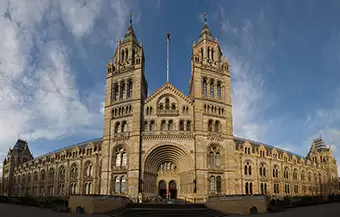
Manufacturing Process
In principle, terracotta panels are made by shaping and firing clay. Clay consists of water, aluminium, silica, carbonaceous substances, magnesium and other natural elements. Once harvested and brought to the plant, clay is blended, ground and screened for impurities. After which it is extruded under pressure and colour treatments are added. Moisture is removed in a dryer and finally it’s fired at very high temperatures ranging up to 1,000 Degree Celsius.
Properties of Terracotta
Terracotta gives a building warmth and character with beautiful, rich, earth-tone colours. Terracotta associates very well with other construction materials viz. glass, metal (“colder” aesthetic materials) and wood, another natural material. Its natural organic tones and variation compliment modern commercial designs. Besides above, terracotta has an array of properties that make it a fantastic facade material:
- It is 100% natural and recyclable
- It is durable
- It requires no maintenance
- It is frost-resistant
- It is non-combustible
- It is resistant to impact
- Because of its low-thermal diffusivity, it contributes to a stable and comfortable indoor temperature during summer
- It has natural sound absorption properties, thus making it an effective noise attenuator.
- It comes in a wide variety of shades and textures (sanded, glazed, grooved, etc.)
- Its unique colours are UV resistant and will not change over time.
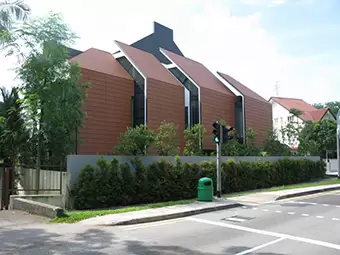
Jalan Kembang Melati
Origin of Modern day terracotta façade material
Terreal was the first manufacturer to develop double skin terracotta claddings over 20 years ago. The first Terracotta panel was born out of partnership between Terreal and the well-known Architect, Renzo Piano, on a very prestigious project, called the “Cite Internationale” in Lyon, France. That project required 120,000 m2 of terracotta façade.
About Terreal:
Terreal is a French group and a world leader in Terracotta (or fired-clay) facade and roofing materials, bricks, and they specialize in cladding products.
The Terreal group was founded in year 2000, uniting forces and expertise of major brands with deep territorial roots like Tuiles Lambert, TBF and TBL Guiraud in France (its first factory started operation in 1855), Ludowici in the USA (established in 1888), and San Marco de Laterizzi in Italy. Terreal has a very strong presence in Asia with Terreal Malaysia SdnBdh (also known as TBF Malaysia) with a sales& marketing office in Kuala Lumpur and a modern state-of- the-art clay roof tile factory in Kluang, Johore. They have a sales& marketing office in Singapore and a representative office in Shanghai, China and in New Delhi, India, managed by IndAccess Marketing.
Terreal has merged local terracotta traditions to cutting edge technology for the development of innovative aesthetic and high performance construction products.
Enquire Now for Cladding
Salient Features of Terreal terracotta cladding solutions
- Broad array of different widths & lengths to get proper scale for the facade different textures available for face of terracotta panels which can be customised depending on various design requirements
- Different textures allow designers to play with shadow effects on the structure
- Various standard and almost unlimited custom colours that are not just “clay” red/orange – can be produced
- They can be installed horizontally or vertically to achieve designer’s vision of the facade
- The colour is permanent and does not fade.
- Rich, warm, earth tone colours are created by extreme heat in the kilns and are not affected by sun.
Terreal Product Range
TERREAL produces and sells various facade systems that can be used depending on the overall design of the building envelope allowing solutions to be offered that are suitable for individual houses, public housing, institutional and commercial projects, both for new builds and renovation. Few of the products are:
- Ventilated facade
- Traditional facade
- Sunscreens
- Acoustic Facade
Energy Efficiency through terracotta façades
A facade made of terracotta, apart from the initial aesthetic and environmental offerings, plays a tremendous part in a building’s energy footprint.
- Terreal’s range of ventilated walls (or rain-screen clad¬ding), brickwork and sunscreens exhibit high levels of energy performance with respect to the numerous criteria included in thermal regulations
- Terreal external insulation system, ventilated or brickwork walls, reduce structural thermal bridges and enable exploitation of the structure’s inertia which is not accessible by insulating from the inside
- Its capacity for cooling in hot climate; the ventilated walls associated with the high thermal inertia of terracotta, less¬ens the thermal shocks in the wall
- Terreal sunscreens, correctly positioned over the facade, reduce the need for excessive air conditioning in buildings with a high proportion of glazing.
- The use of Terreal terracotta ventilated facade combined with Terreal Coolmax reflective insulation reduces the U-value of the opaque walls and thus the Overall Thermal Transmittance Value (OTTV) of the building envelope.
- Terreal sunscreens (or louvers) also reduce the OTTV, thanks to the absorption of solar heat during the day and re-emitting heat to the outside during the night thereby reducing the heat transmittance into the building through the glass windows
For the above reasons, terreal systems are regularly chosen for the construction of low energy consuming, high performance quality buildings and for renovation projects.
Advantages of Terreal Terracotta facades
Our solutions are technically proven and have been installed and are in use since for than twenty years in France and for about a decade in Singapore, in Malaysia, China, Australia, India and are continuing to perform beautifully.
- Easy to install (and remove if necessary)
- Maintenance free & durable – a real plus versus aluminium and wood
- Individually replaceable cladding elements
- Lightweight – enabling a reduced structural costs (from 27kg/m2)
- In building retro-fits or restorations – buildings can remain occupied
- Last but not least they are cost effective
Types of Terreal Facade Systems
#1 BREEZE: Vertical profile and clips type fixing
Breeze® is an extra slim (16mm) double skin rain-screen cladding system of small dimension (30 x 60cm) with overlapping horizontal joints. It offers the advantage of double skin thermal insulation and moisture protection to the building thanks to its complete closed-wall system and provision of ventilation. Its format makes it lighter and easier to install and also more cost-efficient than other large double skin products.
It can be used for new structures as well as for upgrading.
Installation Method:
Breeze® terracotta panels are secured to the vertical T-shaped aluminium profile using the fixing clips fastened with 2 self-tapping stainless steel screws. Vertical aluminium T-shaped profiles are pre-punched with vertical spacing of 25mm. The terracotta tile is well-supported on four points by the clips and on its two smaller sides by the rubber gasket. It can reach a very good wind load resistance of 2380 Pa and flexural strength of 150 daN.
#2 ZEPHIR EVOLUTION: Horizontal rails type fixing
Economic, this single-skin cladding product is lightweight and flexible. Fixed quickly and easily on horizontal rails, it is available in large formats of up to 120cm length and comes in 13 colours, in smooth, sanded, grooved, twin, perforated or glazed finishes.
Installation Method:
Wall-cladding system consisting of single-skin terracotta panels, with support bars on the back side are used for installation on horizontal rails. The horizontal rails are fastened on a vertical framework fixed to the bearing wall. It is possible to install thermal insulation behind the framework.
Installing the vertical framework – made of timber studs or metal profiles – on solid concrete walls or coated masonry must comply with the rules found in CSTB’s Workbooks No.3316/3422/3585 (for timber frames) or No.3194/3586 (for metal frames), including the provision for a ventilated air gap (min 20mm).
Projects: Casa Grande Project
Quick Facts:
- Type: Luxurious lakefront boutique apartments
- Location: Cochin
- Developer: Asset Homes
- Architect: Roy Antony, Roy Antony Architects, Cochin
- Facade contractor: Joseph Manuel, Mech Engineers, Cochin
- Product used: Red Orange Breeze cladding system (300×600)
- Total area of Terreal Facade: 2400 m2
- Year of Completion: 2013
Projects: Adobe Training Center in Noida (New Delhi)
Quick Facts:
- Type: Commercial/IT
- Location: Noida (National Capital Region)
- Architects: SWBI, New Delhi
- Facade Contractor: New Era
- Product used: Piterak XS ventilated rainscreen (red) &Autan XL sunscreen (Red)
- Total area of terreal facade: 6,000 sqm of Piterak XS and 4,350 linear meters of Autan XL
Projects: Villa JalanKembang,
Protective shell with the natural shades of SIENA earth
“We wanted a natural material that could offer good protection against the sun from the west, good sound insulation from traffic and low maintenance over time. Our choice therefore quickly became terracotta.
After some deliberation we felt a natural shade of terracotta would be more authentic. We decided to keep a uniform colour as the terracotta material has inherently subtle tone differences that enrich the façade.” – Said Alan Tay, the project architect:
Quick Facts:
- Type: Residential Villa
- Location: Singapore
- Architect: Formwerkz Architects
- Product: Piterak® Slim
- Colour: 07.Terre de Sienne / 07. Sienna
Whereas façade technology available to the user today knows no bounds with the onslaught of newer and richer and more advanced materials, natural finishes like that of terracotta still remain one of the most preferred and sought after choices.
For more information on terracotta and its applications, readers can write to Julie DEVEYER, Business Development Manager at julie@terreal.com.sg

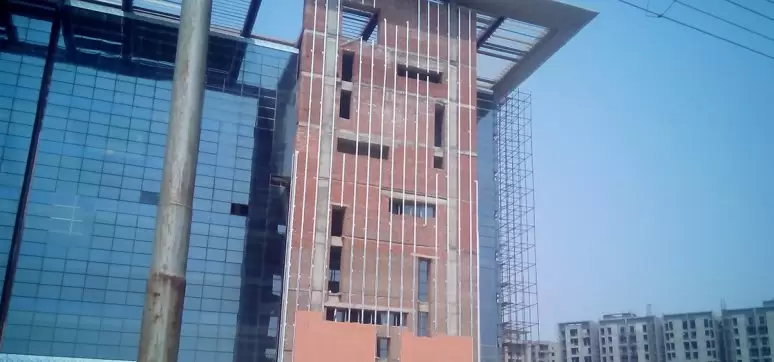
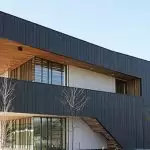
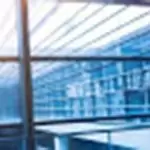
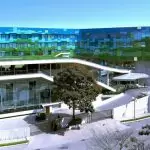


















Post A Comment